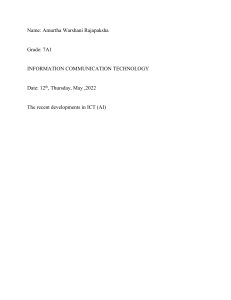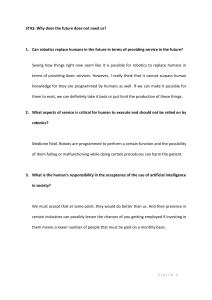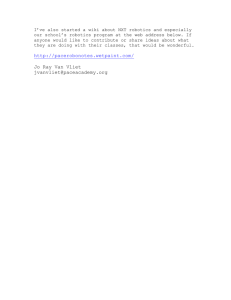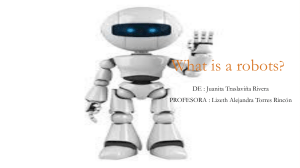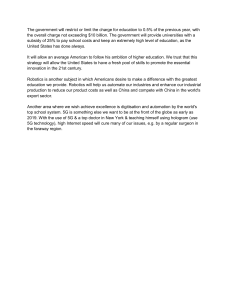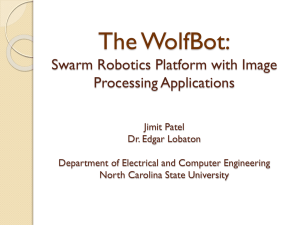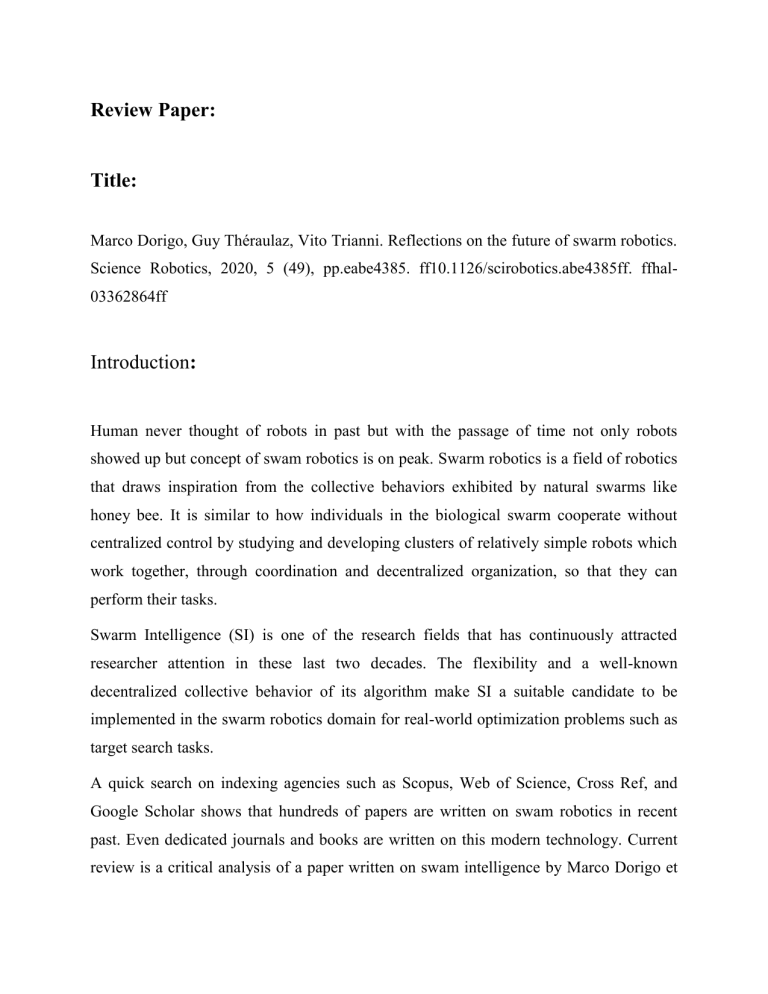
Review Paper: Title: Marco Dorigo, Guy Théraulaz, Vito Trianni. Reflections on the future of swarm robotics. Science Robotics, 2020, 5 (49), pp.eabe4385. ff10.1126/scirobotics.abe4385ff. ffhal03362864ff Introduction: Human never thought of robots in past but with the passage of time not only robots showed up but concept of swam robotics is on peak. Swarm robotics is a field of robotics that draws inspiration from the collective behaviors exhibited by natural swarms like honey bee. It is similar to how individuals in the biological swarm cooperate without centralized control by studying and developing clusters of relatively simple robots which work together, through coordination and decentralized organization, so that they can perform their tasks. Swarm Intelligence (SI) is one of the research fields that has continuously attracted researcher attention in these last two decades. The flexibility and a well-known decentralized collective behavior of its algorithm make SI a suitable candidate to be implemented in the swarm robotics domain for real-world optimization problems such as target search tasks. A quick search on indexing agencies such as Scopus, Web of Science, Cross Ref, and Google Scholar shows that hundreds of papers are written on swam robotics in recent past. Even dedicated journals and books are written on this modern technology. Current review is a critical analysis of a paper written on swam intelligence by Marco Dorigo et al. A search with Google Scholar shows that the phrase “swarm robotics” made its first appearance in 1991, Findings: "Reflections on the Future of Swarm Robotics" by Marco Dorigo, Guy Theraulaz, and Vito Trianni provides an insightful overview of the current state of swarm robotics research and its future directions. The paper begins by defining swarm robotics as the study of large groups of robots that coordinate and cooperate to solve problems or perform tasks, inspired by natural selforganizing systems like social insects, fish schools, or bird flocks. Swarm robotics aims to create systems that are more robust, fault-tolerant, and adaptable than single robots. The introduction emphasizes the need for further research to bring swarm robotics out of the lab and into real-world applications. It highlights key challenges, including the extraction of design principles from biological systems, transitioning from low-level behavioral rules to high-level behavior, addressing the gap between simulations and real experiments, and developing hybrid design methodologies. The paper provides a historical perspective on swarm robotics, tracing its development from a niche field to a mature research domain. It demonstrates how the interest in swarm robotics has grown over the years, highlighting the increasing number of publications and researchers involved in the field. This is very good to see he has given a historical timeline of swarm robotics research domain. The authors present several valuable lessons learned from two decades of swarm robotics research. Key takeaways include: First, he learned that the types of tasks that can currently be performed by robot swarms is strongly constrained by the still limited capabilities of autonomous robots. The capabilities of robot swarms are limited by the current state of autonomous robots. Hardware design and specific sensing abilities are critical for swarm coordination. The micro-macro problem, i.e., designing swarm behavior based on individual robot programming, is one of the most challenging aspects. Swarm properties like scalability, fault tolerance, and adaptability require careful design and attention. Aspects like security, reliability, and explainability need more consideration. The paper outlines several open problems in swarm robotics research, which need to be addressed to advance the field. These include: Developing tools for sharing results and replicating experiments. Creating general-purpose robotic platforms for research. Solving the micro-macro problem and providing performance guarantees. Exploring phase transitions and adaptability in swarm behavior. Enhancing security in robot swarms to prevent external attacks. Leveraging machine learning techniques in swarm robotics. Exploring human-swarm interaction for better control and coordination. The authors anticipate future applications of swarm robotics in fields like precision agriculture, infrastructure inspection, space missions, and medical applications. They highlight the importance of addressing current challenges to enable real-world deployment and make swarm robotics a standard approach for complex robotic systems. "Reflections on the Future of Swarm Robotics" provides a comprehensive overview of the challenges, lessons learned, open problems, and future directions in swarm robotics. The paper serves as a valuable resource for researchers and practitioners interested in the field and offers a roadmap for the development of swarm robotics in various applications. Overall, the paper effectively presents the current state of swarm robotics research and provides a thought-provoking outlook for its future development and applications. Critics: No abstract this is a stature fault. While the paper discusses the challenges and potential applications of swarm robotics, it could benefit from more concrete examples of realworld problems that swarm robotics could solve. Providing specific use cases would help readers better understand the practicality of the field. The paper highlights the limitations of current robot hardware as a significant constraint in swarm robotics. While this is true, it might be valuable to discuss potential solutions or advancements in hardware that could address these limitations. The paper mentions machine learning briefly but doesn't delve into its potential role in swarm robotics. Given the rapid advancements in machine learning, exploring how these techniques can enhance swarm behaviors could be a valuable addition. As swarm robotics is poised to interact more with humans, it would be beneficial to discuss the ethical and social implications of this technology. How might it impact employment, privacy, or security? Addressing these concerns would make the paper more comprehensive. The paper mentions the need for benchmarks and quantitative measures but doesn't delve into existing benchmarks or how different swarm robotics approaches compare. Providing a comparative analysis of existing systems and methodologies would give readers a clearer picture of the state of the field. While the paper outlines several challenges, it would be helpful to delve deeper into each challenge, discussing potential solutions or research directions in more detail. The authors emphasize the need for standardization and shared resources in swarm robotics. It would be interesting to discuss how global collaboration among researchers and institutions could accelerate progress in the field. Swarm robotics has potential applications beyond technical domains. Discussing strategies for engaging policymakers, businesses, and the general public in discussions about its development and deployment could be worthwhile. The paper is also fail to show any practical implementation of the idea so it looks like just an idea for the future but good to see he has included some photos of swarm robots research labs. The paper also does not talk about the issue of swarm robotics collective memory. Also I am fail to see any of the software part or any algorithm reference that how these robots works. Found very limited data on the network they make which is the most important part on this topic.the paper was written back in 2020. Till now may advancements are made like Olympics in South Koria Drone show. Methodology: I have also try to look on the methodology of the research paper and found authors to use a literature review, historical analysis, and critical assessment of the state of swarm robotics to inform their conclusions and recommendations. They draw from previous research in swarm robotics, highlight key lessons learned, discuss open problems, and propose potential research directions for the future. There is a gap in methodology. The Author has not visited any lab personally to study swarm robots in research. He mostly get data from literature available. Also I have not see him talking about the programing language of swarm robots like Buzz. Summary: The design and implementation of effective robot swarms pose significant challenges and opportunities in the field of robotics. The authors explain that, while advances have been made in robotics swarms, further development will be essential to overcome existing obstacles, such as the science of materials, energy storage and AI. The success of robot swarms is accompanied by progress in other areas. The authors state that the hardware and autonomy of robot swarms will have a major impact on developments in materials, energy storage or artificial intelligence. As AI techniques evolve, distributed learning algorithms that work efficiently with limited computation resources will contribute to swarm autonomy. The Author’s literature review is very satisfactory he has given us 143 references in his research paper.. They are also much confident in a field that in vacuum cleaner field swarm robots can give us fully autonomous solutions and this seems too good to see how his research paper is guessing the future on swarm robotic till 2050.
